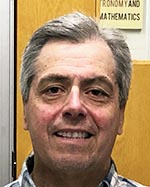Eduardo Flores, Ph.D.
Eduardo Flores, Ph.D.
Eduardo Flores, Ph.D.
Associate Professor
Biography
Website: http://users.rowan.edu/~flores/
Digital Works: https://works.bepress.com/eduardo-flores/
Education:
BS (Physics), NYU Polytechnic Institute
MS (Theoretical Physics), University of Michigan
PhD (Theoretical Physics), University of Michigan
Research Expertise:
Elementary Particle Physics Theory | Foundations of Quantum Physics
I have studied the requirements to materialize quantum effects, and I have found that in order to do so, the conservation laws and physics principles must be met. Additionally, I have discovered that in a physical interaction, there must be sources and carriers of conserved quantities. If any of these conditions are not met, quantum effects do not occur. These findings have been crucial in resolving the alleged violation of complementarity in the Afshar experiment. Furthermore, my research indicates that galactic neutrinos should be treated as a classical ideal gas.
I have constructed a simplified model of a classical ideal gas comprising galactic neutrinos, which incorporates the effects associated with dark matter to a reasonable extent. You can find the details in the following link: arXiv:2208.12267. Since neutrinos are particles predicted by the Standard Model of particles, it would significantly enhance the Standard Model's standing if galactic neutrinos were indeed identified as dark matter. Furthermore, it is plausible that low-energy neutrinos and antineutrinos would be in equilibrium, as annihilation would only produce pairs of the same type. It should be noted that there might be an adequate surplus of antineutrinos to restore particle-antiparticle symmetry in the universe. Through my research, I have determined that if galactic neutrinos behave as a classical ideal gas, gravity would not function as a quantum force, but rather as a distortion of spacetime, as predicted by general relativity.
Quantum field theory postulates that the vacuum is filled with energy, and in many calculations, the total energy diverges. This divergence is one of the numerous infinite quantities arising from the theory's assumption of continuous space and time. Fortunately, in the Standard Model of particles, these types of infinities can be regulated through a technique known as renormalization, which produces finite results that can be experimentally tested. However, since renormalization cannot be applied to all theories, we must find alternative approaches to address the source of these infinities directly. One proposed solution is the concept of discrete space and time, suggesting that they may not be continuous. However, in my work, I tackle the issue of infinities by considering the assumption of discrete fields. In this model, discrete fields are akin to a discrete atomic lattice, while particles continue to move within continuous space and time. These discrete fields have an impact on the motion of particles.
Professor Tom Osler, from Rowan University, has made a significant discovery of a unique number that bears resemblance to complex numbers. This particular number, known as the spacetime number, has captured our attention and prompted our involvement in a project aimed at incorporating spacetime numbers into the realm of high energy physics. We strongly believe that spacetime numbers naturally belong to the language of high energy physics theories.
Recent Publications:
E. Flores, Materializing Quantum Effects: Dark Mater, arXiv:2208.12267

